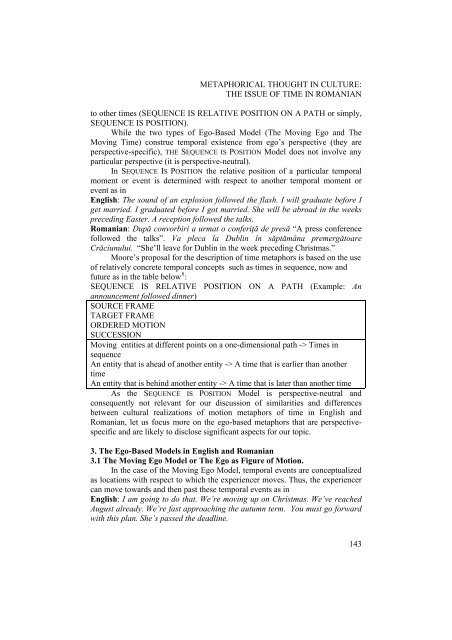culture, subculture and counterculture - Facultatea de Litere
culture, subculture and counterculture - Facultatea de Litere
culture, subculture and counterculture - Facultatea de Litere
You also want an ePaper? Increase the reach of your titles
YUMPU automatically turns print PDFs into web optimized ePapers that Google loves.
METAPHORICAL THOUGHT IN CULTURE:<br />
THE ISSUE OF TIME IN ROMANIAN<br />
to other times (SEQUENCE IS RELATIVE POSITION ON A PATH or simply,<br />
SEQUENCE IS POSITION).<br />
While the two types of Ego-Based Mo<strong>de</strong>l (The Moving Ego <strong>and</strong> The<br />
Moving Time) construe temporal existence from ego’s perspective (they are<br />
perspective-specific), THE SEQUENCE IS POSITION Mo<strong>de</strong>l does not involve any<br />
particular perspective (it is perspective-neutral).<br />
In SEQUENCE IS POSITION the relative position of a particular temporal<br />
moment or event is <strong>de</strong>termined with respect to another temporal moment or<br />
event as in<br />
English: The sound of an explosion followed the flash. I will graduate before I<br />
get married. I graduated before I got married. She will be abroad in the weeks<br />
preceding Easter. A reception followed the talks.<br />
Romanian: După convorbiri a urmat o conferiţă <strong>de</strong> presă “A press conference<br />
followed the talks”. Va pleca la Dublin în săptămâna premergătoare<br />
Crăciunului. “She’ll leave for Dublin in the week preceding Christmas.”<br />
Moore’s proposal for the <strong>de</strong>scription of time metaphors is based on the use<br />
of relatively concrete temporal concepts such as times in sequence, now <strong>and</strong><br />
future as in the table below 8 :<br />
SEQUENCE IS RELATIVE POSITION ON A PATH (Example: An<br />
announcement followed dinner)<br />
SOURCE FRAME<br />
TARGET FRAME<br />
ORDERED MOTION<br />
SUCCESSION<br />
Moving entities at different points on a one-dimensional path -> Times in<br />
sequence<br />
An entity that is ahead of another entity -> A time that is earlier than another<br />
time<br />
An entity that is behind another entity -> A time that is later than another time<br />
As the SEQUENCE IS POSITION Mo<strong>de</strong>l is perspective-neutral <strong>and</strong><br />
consequently not relevant for our discussion of similarities <strong>and</strong> differences<br />
between cultural realizations of motion metaphors of time in English <strong>and</strong><br />
Romanian, let us focus more on the ego-based metaphors that are perspectivespecific<br />
<strong>and</strong> are likely to disclose significant aspects for our topic.<br />
3. The Ego-Based Mo<strong>de</strong>ls in English <strong>and</strong> Romanian<br />
3.1 The Moving Ego Mo<strong>de</strong>l or The Ego as Figure of Motion.<br />
In the case of the Moving Ego Mo<strong>de</strong>l, temporal events are conceptualized<br />
as locations with respect to which the experiencer moves. Thus, the experiencer<br />
can move towards <strong>and</strong> then past these temporal events as in<br />
English: I am going to do that. We’re moving up on Christmas. We’ve reached<br />
August already. We’re fast approaching the autumn term. You must go forward<br />
with this plan. She’s passed the <strong>de</strong>adline.<br />
143












